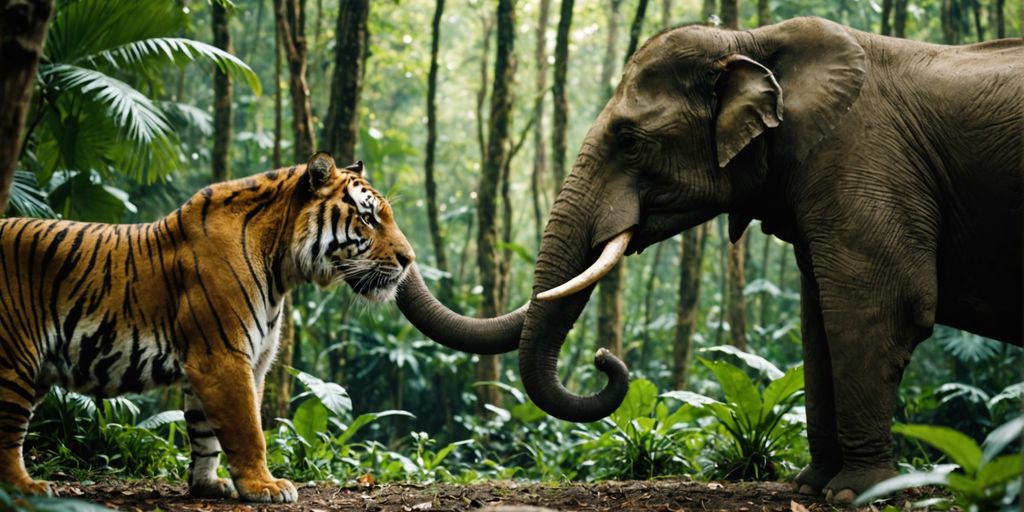Your Cart is Empty
🙏HELP US SAVE TIGERS!🐅 WE DONATE 1% OF OUR SALES TO WILDLIFE ORGANIZATIONS ( WWF ...)
Menu

🙏HELP US SAVE TIGERS!🐅 WE DONATE 1% OF OUR SALES TO WILDLIFE ORGANIZATIONS ( WWF ...)
Are There Tigers in Africa?
May 28, 2021 13 min read

Are There Tigers in Africa? The Shocking Truth Revealed!

Introduction
Curiosity and misconceptions surrounding tigers in Africa have sparked much intrigue and speculation. But what is the truth? Are there tigers roaming the African jungles? In this article, we will delve into the shocking truth about tigers in Africa and debunk any misconceptions that may have fueled the belief in their presence on the continent.
"Are there tigers in Africa? This question has puzzled many, leading to a range of theories and speculations. Some believe that these majestic creatures once roamed across the African savannahs, while others are convinced that they still lurk in the dense jungles. However, the reality is quite different. Brace yourself for the shocking truth: there are no wild tigers currently residing in Africa."
The Origin and Migration of Tigers

The origins of tigers can be traced back to Asia, where they have historically been present. Fossil evidence supports the theory of tiger migration to Africa millions of years ago, indicating their initial presence on the continent. The migration of tigers from Asia to Africa is a subject of scientific interest and has been supported by various pieces of evidence, including fossil records that provide valuable insights into the historical distribution of these magnificent creatures.
Evolution and Spread of Tigers
Tigers are believed to have evolved in Asia and subsequently migrated to other regions, including Africa, before eventually becoming extinct in the latter. This migration is thought to have occurred millions of years ago and is attributed to a variety of factors, including changes in climate, geographic boundaries, and other ecological influences that shaped the distribution of species over time.
Understanding Tiger Migration
The theory of tiger migration to Africa offers a fascinating glimpse into the ancient movements of these iconic predators and provides valuable context for understanding their historical presence on the continent. By examining the scientific evidence available, researchers continue to unravel the mysteries surrounding the migration patterns of tigers and their enduring legacy in different parts of the world.
Debunking the Myth: Tigers in African Savannah

The absence of tigers in Africa is a fact that is backed by experts and scientific evidence. Despite popular belief and misconceptions, there are no wild tigers currently residing in Africa. Here are some key points to debunk the myth of tigers in African jungles:
Expert Consensus: Tigers are Exclusive to Asia
The consensus among wildlife experts and conservation organizations is that tigers are not native to Africa. These experts have conducted extensive research and field studies to understand the distribution of tigers worldwide. Their findings unanimously confirm that tigers are exclusive to Asia.
Confusion with Other Large Cats
One of the main reasons for the misconception about tigers in Africa is the confusion with other large cats like leopards. Leopards, which are native to Africa, share some physical similarities with tigers, such as their striking coat patterns. This resemblance has led to misidentifications and false reports of tiger sightings in African jungles.
Lack of Fossil Records and Historical Evidence
The theory of tiger migration to Africa millions of years ago is not supported by scientific evidence such as fossil records. Tigers have a well-documented evolutionary history in Asia, with no substantial evidence indicating their presence in Africa.
Ecological Differences between Asia and Africa
Tigers have evolved to adapt to specific ecosystems in Asia, such as dense rainforests, grasslands, and even snow-covered landscapes. The African continent, with its unique geography and diverse habitats, does not provide suitable conditions for tiger survival. The absence of tigers in Africa can be attributed to Pleistocene glacial fluctuations, geographic boundaries like the Sahara Desert, and the Great East African Rift Valley.
In conclusion, it is important to dispel the myth that tigers reside in African jungles. The absence of wild tigers in Africa is a result of their evolutionary history and ecological differences between Asia and Africa. By understanding this truth, we can focus our conservation efforts on protecting the remaining tiger populations in their native range and supporting initiatives that ensure their survival for future generations.
By the way, you can enjoy a Tiger T-shirt right here.⤵️
Tigers' Native Range
Tigers are naturally found in various regions across Asia. Here are some key areas where tigers have historically thrived:
-
India: India is home to the highest number of tiger populations, with approximately 70% of the global tiger population residing here. The country's diverse landscapes, including dense forests and grasslands, provide ideal habitats for these majestic cats.

- Russia: The Siberian tiger, also known as the Amur tiger, is found primarily in the Russian Far East. These tigers have adapted to survive in harsh climates with freezing temperatures and deep snow cover.
- Indonesia: The critically endangered Sumatran tiger is found on the Indonesian island of Sumatra. They inhabit tropical rainforests and are known for their unique adaptations to this environment.
- Bangladesh: The Sundarbans mangrove forest in Bangladesh is home to the Bengal tiger. These tigers are skilled swimmers and have adapted to living in a habitat where water is abundant.
- Nepal: Tigers can also be found in the Terai Arc Landscape of Nepal, which includes national parks such as Chitwan and Bardia. These protected areas offer suitable habitats for tigers to roam freely.
- Malaysia: The Malayan tiger is native to the southern tip of the Malay Peninsula and parts of southern Thailand. They inhabit both primary and secondary forests within this region.
It's important to note that while tigers have historically been found in these regions, their populations have significantly declined due to various threats such as poaching and habitat loss.
Conservation efforts are crucial to protect these remaining tiger populations and their natural habitats.
By understanding the native range of tigers, we can better appreciate their ecological significance and work towards ensuring their long-term survival in their respective habitats.
Historical Context
Ancient Art and Literature
- Ancient Egyptian and Mesopotamian art and literature have depicted large feline predators, but there is no concrete evidence to suggest that these were tigers.
Greek and Roman Accounts
- Greek and Roman writings mention large cats in North Africa, but again, it is unclear whether these references pertain to tigers or other big cats.
Colonial Records
- European explorers and colonizers in Africa documented encounters with various wildlife, but there are no verified records of tiger sightings during this period.
Circus and Menageries
- In the 19th and early 20th centuries, traveling circuses and menageries showcased exotic animals in Africa. While some may have included tigers, these instances were purely for entertainment and not indicative of wild tiger populations on the continent.
Contemporary Reports
- Unsubstantiated claims and occasional sightings of tigers in remote regions continue to surface, often fueled by local folklore or misidentification of other large cats.
The historical context surrounding tigers in Africa is shrouded in ambiguity, with no concrete evidence supporting the presence of wild tiger populations on the continent. While ancient art, literature, and colonial records hint at encounters with large feline predators, the specific identification of these animals as tigers remains inconclusive. Contemporary reports of tiger sightings are similarly clouded by uncertainty, making it challenging to ascertain any documented cases of tigers in Africa.
Adaptation to Diverse Environments: Tigers' Success Story in Asia

Tigers are known for their remarkable ability to adapt to a wide range of environments across Asia. From dense rainforests to snow-covered landscapes, these majestic creatures have proven their resilience and survival skills. Here are some key points highlighting the success story of tigers in different habitats:
1. Thriving in Rainforests
Tigers have shown incredible adaptability in navigating through dense rainforests. Their powerful limbs and sharp claws allow them to move swiftly through the thick vegetation, making them efficient hunters. In Southeast Asia, where dense rainforests are abundant, tigers have managed to establish stable populations despite the challenges posed by this complex environment.
2. Mastering Snow-covered Landscapes
In the cold and harsh regions of Siberia, tigers have adapted to survive in snow-covered landscapes. Their thick fur provides insulation against the freezing temperatures, while their large paws act as snowshoes, enabling them to traverse snowy terrain with ease. This adaptation showcases their ability to thrive even in extreme conditions.
3. Conquering Mangroves
Tigers are also known for their exceptional swimming abilities, which enable them to inhabit regions with abundant water sources like mangroves. They can effortlessly swim long distances and even hunt prey in water. The Sundarbans mangrove forest in Bangladesh and India is a prime example of a tiger habitat that consists of vast stretches of mangrove swamps.
4. Versatility as Ambush Predators

Tigers are highly skilled ambush predators, capable of adapting their hunting techniques depending on the terrain they inhabit. Whether it's the tall grasslands of India or the rocky slopes of Southeast Asia, tigers utilize their camouflage and patience to stalk and ambush their prey effectively.
The adaptability of tigers to diverse environments is a testament to their evolutionary success. Their ability to thrive in various habitats across Asia is a result of millions of years of adaptation and natural selection. However, despite their remarkable adaptability, tigers continue to face numerous conservation challenges that threaten their survival in the wild.
Conservation Challenges Faced by Tigers in Their Native Range
Threats to Tiger Populations
- Poaching for body parts: Tiger populations in Asian countries are under constant threat due to widespread poaching driven by demand for their body parts in traditional medicine and luxury markets. The illegal trade in tiger skins, bones, and other body parts continues unabated despite efforts to combat it.
- Loss of habitats: Deforestation and human encroachment have resulted in the loss and fragmentation of tiger habitats. Rapid clearing of forests for agriculture and settlements has deprived tigers of their hunting grounds and breeding areas.
Impact on Tiger Survival
- Poaching: The relentless poaching activities have severely depleted tiger populations, pushing them closer to extinction.
- Habitat loss: The shrinking and degradation of tiger habitats have not only directly reduced their numbers but also increased conflicts between tigers and humans as these apex predators venture into human settlements in search of food.
The combined effect of poaching and habitat loss poses a grave threat to the survival of tigers across their native range. Urgent and sustained conservation measures are crucial to protect these magnificent creatures for future generations.
The Role of Zoos in Tiger Conservation
The role of zoos in tiger conservation is crucial for safeguarding endangered tiger species and raising public awareness. Zoological institutions play a significant part in the preservation of these majestic animals through the following initiatives:
Breeding Programs
Accredited zoos actively participate in breeding programs aimed at increasing the population of endangered tigers. By carefully managing breeding pairs and ensuring genetic diversity, zoos contribute to the long-term survival of tiger species.
Public Education
Zoos serve as educational platforms, offering insights into the lives of tigers and the challenges they face in the wild. Through informative exhibits, guided tours, and educational events, zoos raise public awareness about tiger conservation and the importance of protecting these iconic creatures.
Research and Advocacy
Zoos engage in vital research efforts to better understand tiger behavior, health, and habitat requirements. Additionally, they advocate for policies and practices that support tiger conservation on a global scale.
By engaging visitors and fostering a deeper understanding of tigers' plight, zoos inspire individuals to become advocates for wildlife conservation. Through their efforts, accredited zoological institutions contribute significantly to the protection and preservation of endangered tiger species.
Tigers in Captivity: A Complex Issue
The captive tiger population is a subject that raises both legitimate conservation efforts and ethical concerns. Here is an overview of the current situation worldwide:
1. Captive Tiger Population
There are currently thousands of tigers held in captivity around the world. These tigers can be found in zoos, private collections, circuses, and even as pets. The exact number is difficult to determine due to the lack of comprehensive records and illegal activities.
2. Conservation Efforts
Many accredited zoological institutions play a crucial role in tiger conservation through breeding programs and public education initiatives. These institutions aim to maintain genetically diverse populations and provide a safe environment for tigers while raising awareness about their plight in the wild.
3. Controversial Practices
Private ownership of tigers is a highly controversial issue. While some individuals may have good intentions and genuinely care for the animals, others exploit them for personal gain or engage in illegal activities such as breeding for the exotic pet trade. This can lead to poor living conditions, inadequate care, and even endangerment of both humans and tigers.
4. Regulation and Legislation
Governments and international organizations are working towards implementing stricter regulations and legislation to address the issues surrounding captive tigers. Efforts are being made to ensure that only accredited facilities with proper expertise and resources are allowed to house tigers.
5. Alternatives to Captivity
Some organizations advocate for alternatives to traditional captive settings, such as sanctuary environments where tigers can live in large, naturalistic enclosures with minimal human interference. These sanctuaries focus on providing the best possible quality of life for captive tigers while also addressing their physical, social, and psychological needs.
It is important to consider both sides of the captive tiger issue. While some facilities contribute positively to conservation efforts, there are significant concerns regarding private ownership and improper care. Stricter regulations and increased public awareness are essential to ensure the well-being of captive tigers and their long-term survival.
Protecting Tigers Where They Belong: Conservation Initiatives in Asia
Conservation initiatives aimed at protecting tigers in their native range have become crucial in the face of their declining populations. These efforts focus on preserving tiger habitats and engaging local communities as key stewards in the conservation process.
Some successful on-the-ground projects have been implemented to safeguard tiger populations and their habitats in Asia. These initiatives have shown promising results in ensuring the survival and well-being of these endangered creatures. Here are some key examples:
Tiger Reserves
In countries like India, dedicated tiger reserves have been established to provide protected areas for these magnificent creatures. These reserves not only serve as safe havens for tigers but also contribute to the conservation of other wildlife species that share their habitat.
Anti-Poaching Units
Many conservation organizations are working tirelessly to combat poaching, which remains a grave threat to tiger populations. Anti-poaching units are deployed in key tiger habitats to monitor and intercept illegal activities such as the hunting and trade of tiger parts.
Habitat Restoration
Efforts are being made to restore and rehabilitate degraded tiger habitats. This includes reforestation projects, restoring water sources, and implementing sustainable land-use practices to ensure an adequate prey base for tigers.
Community Engagement
Local communities play a vital role in tiger conservation. By involving them in decision-making processes, providing alternative livelihood options, and raising awareness about the importance of tigers, conservation efforts can be more effective and sustainable.
Education and Awareness Programs
Education and awareness programs targeting both local communities and the general public are crucial for promoting a deeper understanding of the value of tigers and their conservation needs. These programs aim to foster a sense of ownership and responsibility towards protecting these iconic species.
These initiatives demonstrate the importance of on-site conservation measures and the engagement of local communities in ensuring the long-term survival of tigers. By working together, we can secure a future for these majestic creatures and preserve the biodiversity of our planet.
Beyond Boundaries: International Collaboration for Tiger Conservation
International collaboration is crucial in the global efforts to save tigers from the brink of extinction. Governments, NGOs, and concerned citizens worldwide have come together with a collective commitment to achieving the goal of doubling wild tiger populations by 2022, which has been designated as the Year of the Tiger.
Here are some key points highlighting the importance of international collaboration in tiger conservation:
1. Policy and Advocacy
- Governments play a vital role in formulating policies and enacting legislation to protect tigers and their habitats.
- International agreements such as the Convention on International Trade in Endangered Species of Wild Fauna and Flora (CITES) regulate trade in tiger parts and products, ensuring that they are not exploited illegally.
2. Funding and Support
- International organizations and donors contribute significant financial resources to support tiger conservation projects.
- For example, the Global Tiger Initiative (GTI) brings together governments, international organizations, and civil society to mobilize funding for conservation efforts across tiger range countries.
3. Scientific Research
- Collaborative research efforts enable scientists to gather data on tiger populations, behavior, and habitat requirements.
- This information is crucial for developing effective conservation strategies and monitoring the progress of conservation initiatives.
4. Capacity Building
- International collaboration facilitates knowledge-sharing and training programs that enhance the capacity of local communities and conservation practitioners in tiger range countries.
- These capacity-building initiatives empower individuals with the necessary skills to protect tigers and their habitats effectively.
5. Public Awareness
- NGOs and concerned citizens raise awareness about tiger conservation through public campaigns, education programs, and social media advocacy.
- By engaging people from all walks of life, international collaboration helps create a global movement dedicated to saving tigers.
Through international collaboration, we can leverage diverse expertise, resources, and perspectives to address the complex challenges facing tigers. Together, we can ensure that these magnificent creatures continue to roam our planet for generations to come.
Tigers vs Lions: Understanding the Difference
Here are some key differences between tigers and lions:
- Physical Appearance: Tigers have striking striped fur and a muscular build, while lions have a tawny coat and a more robust mane (in the case of males).
- Hunting Behavior: Tigers are solitary hunters, relying on stealth and ambush to catch their prey. On the other hand, lions often hunt in groups, using coordinated tactics to take down larger animals.
Looking Ahead: Securing a Future for Tigers
As we look towards the prospects for tigers, it's crucial to explore innovative approaches that can ensure their survival in the long run. Here are some key talking points to consider:
Technology-Driven Anti-Poaching Strategies
- The use of advanced surveillance technologies, such as drones, camera traps, and satellite monitoring, plays a vital role in combating poaching activities.
- These tools provide real-time data and enable rapid response to potential threats, bolstering the protection of tiger populations.
Landscape-Level Conservation Planning
- Emphasizing the interconnectedness of ecosystems and habitats is essential for effective tiger conservation.
- Implementing landscape-level planning allows for the preservation of large, contiguous areas that support diverse wildlife, including tigers.
- This holistic approach also involves engaging local communities in sustainable land use practices to mitigate human-wildlife conflicts.
By embracing these forward-thinking strategies, there is hope for safeguarding the future of tigers amidst the myriad challenges they face.
Conclusion
The shocking truth about tigers in Africa is that they simply do not exist in the wild. Despite popular misconceptions and occasional sightings, experts agree that there are no native populations of tigers on the African continent. Tigers are native to Asia, where they have evolved and adapted to various habitats over millions of years.
The Importance of Tiger Conservation
It is important to reiterate this fact and dispel any myths surrounding tigers in Africa. While it may be disappointing for some to learn that these majestic creatures do not roam the African jungles, it is crucial to focus our conservation efforts on their remaining habitats in Asia.
To ensure the survival of tigers, we must support reputable organizations working towards tiger conservation. Donations and spreading awareness are two effective ways to contribute to these efforts. By supporting initiatives that combat poaching, protect tiger habitats, and promote sustainable practices, we can help secure a future for these endangered animals.

Our Responsibility as Global Citizens
While there are no tigers in Africa, our responsibility lies in protecting their remaining populations in Asia. Let us come together as a global community to safeguard these iconic creatures and ensure that future generations can continue to marvel at their beauty and grace.
"The greatness of a nation and its moral progress can be judged by the way its animals are treated." - Mahatma Gandhi
If that is not enough for you, you can take a look at our paintings directly inspired by representations of the African Tiger. This way, you will be able to impress your friends and family with a whole bunch of anecdotes about the false beliefs that revolve around the big cat and the African savannah!
Also in Tiger Blog

Sloth Bear vs Tiger: Who Would Win?
July 13, 2024 7 min read
Explore the thrilling showdown between a sloth bear and a tiger, analyzing their strengths, behaviors, and survival tactics.
Read More
Tiger vs Elephant: Who Reigns Supreme in the Animal Kingdom?
July 13, 2024 7 min read
Explore why elephants usually triumph over tigers in the wild, highlighting their size, strength, and defensive prowess.
Read More
Epic Battle: Polar Bear vs Tiger, who win?
July 11, 2024 8 min read
Epic showdown: Polar Bear vs Tiger. Discover who would win in this thrilling battle of nature's fiercest predators.
Read More
